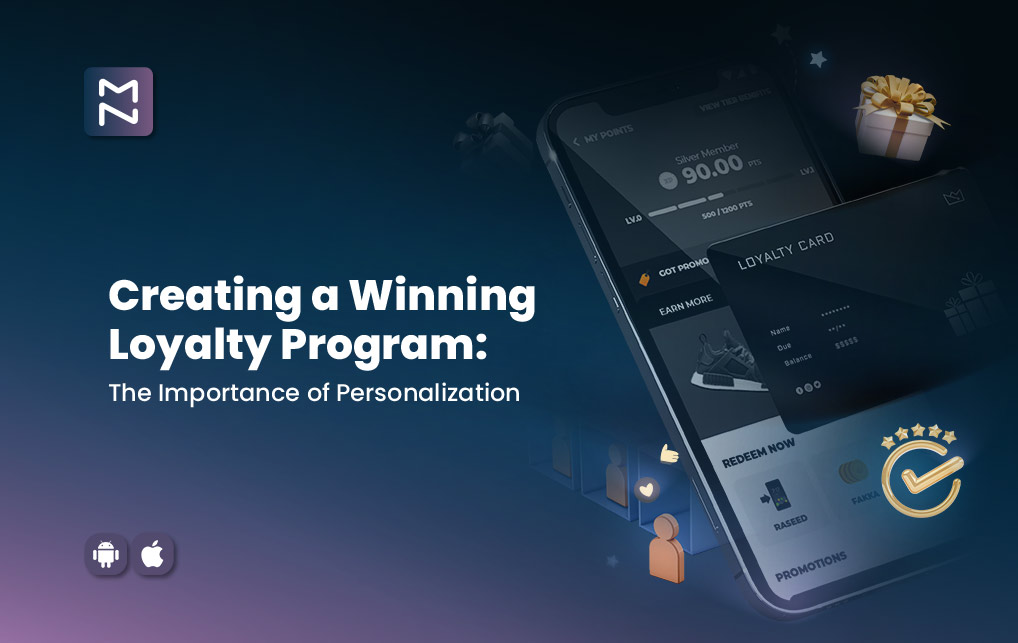Customer loyalty program have become increasingly popular in recent years as businesses seek to attract and retain customers in a highly competitive marketplace.
These programs offer rewards, discounts, and other incentives to customers who make repeat purchases or demonstrate brand loyalty differently.
- Adding a personalized touch to your loyalty program makes it ten times better. It helps loyalty programs go the extra mile by tailoring rewards and incentives to individual customers’ specific needs and preferences.
- It makes customers feel valued and understood, increasing customer satisfaction and loyalty.
- Personalization has enhanced loyalty programs by allowing businesses to track and analyze customer behaviour in real time. Using data analytics tools, businesses can gain insights into what motivates their customers to purchase and tailor rewards accordingly.
- It can lead to numerous benefits, including higher customer engagement, increased customer retention, and improved customer lifetime value. Additionally, it can help differentiate your brand from competitors and enhance your reputation as a customer-centric business.
Table of Content
- What is a customer loyalty program?
- What are the types of consumer loyalty programs?
- Why is personalized customer experience key for loyalty programs?
- How to keep customers loyal with personalization?
- How to design a tailored loyalty program?
- How can personalization boost your loyalty program?
- How to implement and promote your loyalty program?
- Examples of Successful Tailored Loyalty Programs
- Signing Off
1. What Is A Customer Loyalty Program?
It is a marketing strategy that incentivizes customers to continue purchasing from a particular brand or business. Loyalty programs offer them rewards, discounts, or other incentives for continued loyalty. Its goal is to encourage customers to return and make repeat purchases, increasing customer lifetime value and driving revenue growth for the business.
Loyalty programs can take many forms: points-based systems, tiered reward programs, cash-back offers, or exclusive access to events or products. The specifics of the loyalty program will depend on the goals and needs of the business and the preferences and behaviours of the target customer base.
Loyalty programs provide benefits that include increased customer retention, improved customer satisfaction, and higher customer lifetime value.
Additionally, loyalty programs can help you differentiate yourself from competitors and enhance your reputation as a customer-centric brand.
A well-designed loyalty program can effectively build and maintain strong customer relationships, driving long-term growth and success for the business.
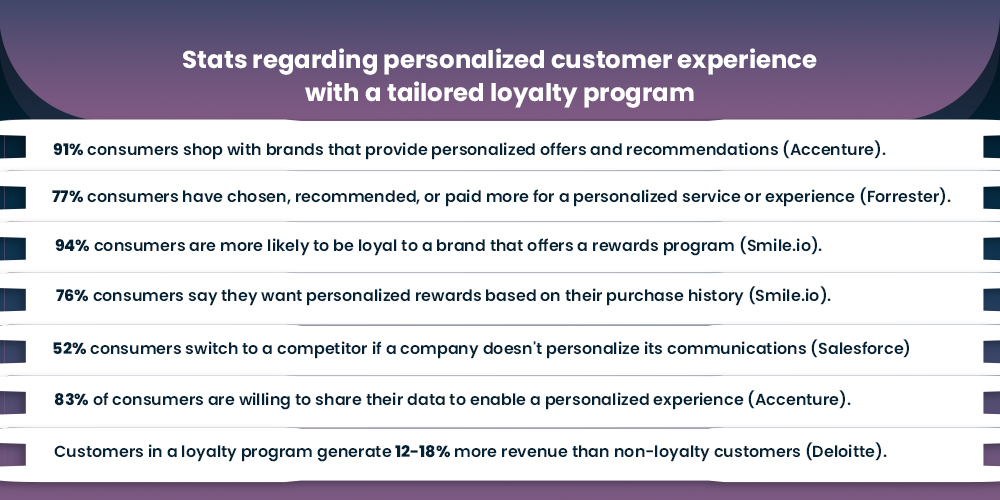
2. What Are The Different Types Of Customer Loyalty Programs?
Let’s understand the four main types of customer loyalty programs:
I. Points-based loyalty programs
They are one of the most popular types of loyalty programs. In this program, customers earn points for making purchases, which can be redeemed for rewards such as discounts, free products, or exclusive experiences.
Customers can gain by engaging with the brand on social media, referring friends, or leaving reviews. Points-based loyalty programs are easy to understand and offer customers a clear path to earning rewards.
II. Tiered loyalty programs
They are structured based on different tiers or levels of membership. Customers can progress through the levels by making purchases or engaging with the brand, unlocking additional benefits and rewards at each level. Tiered loyalty programs can encourage customers to purchase more to unlock higher levels and reap greater rewards.
III. Paid loyalty programs
In it, customers pay a fee to become a member and receive exclusive benefits and rewards like Amazon Prime. Paid loyalty programs can provide significant value to customers and incentivize them to continue purchasing from the brand to make the most of their membership.
IV. Value-based loyalty programs
They focus on rewarding customers for valuable behaviours to the brand, such as repeat purchases, referrals, or social media engagement. In this program, rewards may not be directly tied to points or tiers but to specific behaviours.
A mobile app with a loyalty program integration can provide your customers with a much better user experience. Having everything at their fingertips with the best offers and rewards personalized according to their needs and wants. A mobile app with the best loyalty program integration can have a higher retention rate. Here are some best loyalty program integrations that can give your business the much-needed push.
3. Why Is Personalized Customer Experience Key For Loyalty Programs?
Personalization is critical for loyalty programs for several reasons:
I. Builds stronger relationships
Personalized experiences help build stronger relationships between customers and brands. Customers are more likely to feel connected to the brand and develop a sense of loyalty when they feel that it understands their individual needs and preferences.
II. Increases customer satisfaction
They can help by providing customized solutions that meet their needs. Customers who feel satisfied with their experience are more likely to continue doing business with the brand.
III. Enhances customer engagement
When a brand provides customers with content, offers, and promotions relevant to their interests, it increases customer engagement. This can encourage customers to engage with the brand more frequently and to spend more time and money on the brand.
IV. Improves retention rates
It can help by compelling customers to continue doing business with the brand. Customers who feel a brand understands their needs and values loyalty are less likely to switch to a competitor.
Also Read : User Insights – The Backbone For Improving App Experience
V. Increases customer lifetime value
Personalized experiences help increase lifetime value by encouraging customers to make frequent purchases and spend more money with the brand over time. When customers feel valued and appreciated, they are more likely to continue doing business with the brand and make larger purchases.
These stats are proof of how impactful customer loyalty is:
In the U.S., there are 3.3 billion loyalty memberships. (Accenture)
The average consumer is a member of 14.8 loyalty programs but actively participates in only 6.7 (Bond)
Only 18% of consumers engage with all the loyalty programs they participate in (Code Broker)
65% of consumers engage with less than half of the loyalty programs they are enrolled in (Code Broker)
15% of members interact with their loyalty programs daily, an increase from 10% in 2015 (PDI)
Loyalty program membership in the United States grew by 26.7% from 2012 to 2014 (Accenture)
49% of consumers are members of up to three loyalty programs (Yotpo)
Less than 8% of consumers consider rewards unimportant when purchasing (Wirecard)
4. How To Keep Customers Loyal With Personalization?
Keeping customers loyal with personalization requires creativity, attentiveness, and responsiveness to customer needs and preferences. By implementing these strategies, businesses can build stronger customer relationships, foster long-term loyalty, and drive sustainable growth.
I. Be as generous as your customers
Offering promotions, discounts, or loyalty rewards as generous as your customers’ loyalty can help build stronger relationships and keep customers coming back.
II. Show your gratitude
Sending personalized thank-you messages, offering exclusive perks or promotions, or even a small gift can make customers feel appreciated and valued.
III. Provide benefits with every purchase
Offering rewards, discounts, or other benefits can make customers feel like they’re receiving personalized treatment and help incentivize repeat business.
IV. Scratch the program altogether
Sometimes, traditional loyalty programs may not work. Instead, consider creative alternatives such as surprise and delight campaigns, personalized experiences, or charitable donations on behalf of customers.
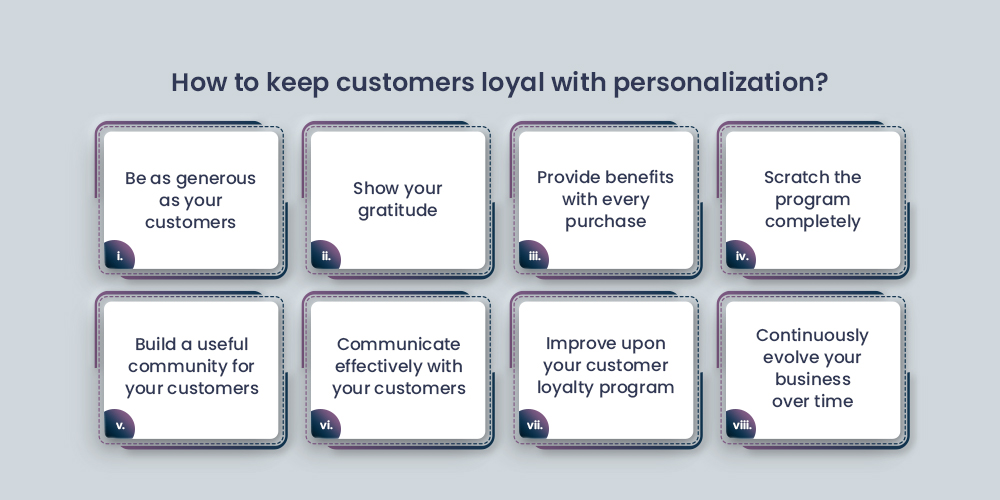
V. Build a valuable community for your customers
Creating a community or forum where customers can connect, interact, and provide feedback can help foster a sense of belonging and keep customers engaged with your brand.
VI. Communication is the key
Regular communication, such as newsletters or targeted marketing campaigns, can help keep customers engaged and informed about new products, promotions, or company updates.
VII. Improve upon your customer loyalty program
Continuously evaluating and improving your loyalty program based on customer feedback and data can help ensure it remains relevant and effective at incentivizing repeat business.
VIII. Continuously evolve your business over time
Change is inevitable, and customer needs and preferences keep changing. Constantly developing your product offerings, customer service, and overall strategy can ensure you remain competitive and relevant to your customers.
Give Your E-commerce Business A New Direction With Full-Featured Mobile App At Cost-Efficient Price
5. How To Design a Tailored Loyalty Program?
Here is a breakdown of how to design a tailored loyalty program:
I. Defining the objectives and goals of the loyalty program
It’s important to define them clearly. This includes determining what you hope to achieve with the program, such as increasing customer retention or driving more sales.
II. Types of rewards and benefits to offer
Determining what rewards and benefits are the next steps. This can include discounts, exclusive offers, free products or services, or access to special events.
III. Customizing the program based on customer segments
To make your loyalty program as effective as possible, you must customize it based on customer segments. This means identifying different types of customers and tailoring the program to meet their specific needs and preferences.
IV. Determining the program’s structure and rules
The design and rules of the loyalty program should be easy to understand, like determining how customers earn and redeem rewards. How long are rewards valid, and any limitations or restrictions?
V. Understanding and analyzing your customers
By collecting and analyzing customer data, you can create tailored experiences, offers, and recommendations that resonate with individual customers on a personal level.
Customer data can include various information, such as purchase history, browsing behavior, demographic data, and feedback or reviews. By leveraging this data, you can gain insights into what products or services customers are interested in and their purchasing patterns.
VI. Collecting and analyzing customer data
There are various methods for collecting and analyzing customer data, including
- Surveys
- Customer Relationship Management (CRM) software
- Website analytics
- Social media listening
VII. Identifying customer segments based on behavior and preferences
You can use customer data to identify customer segments based on behavior and preferences. Customer segmentation can be based on various factors, such as age, gender, location, purchase behavior, and interests.
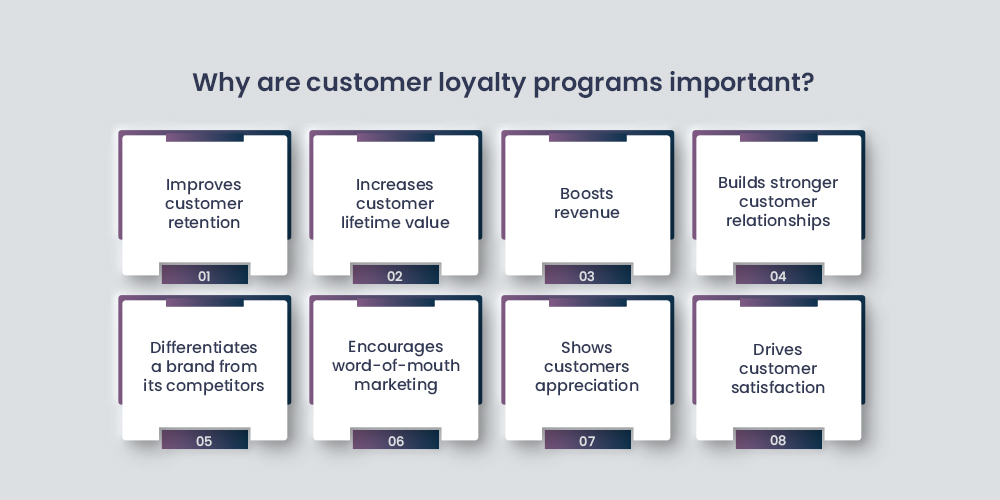
6. How Can Personalization Boost Your Loyalty Program?
Here are five ways in which personalization can boost your loyalty program:
I. Create Dashboards
Dashboards can give customers personalized insights into their purchase history, rewards progress, and other relevant data. By giving customers access to this information, they can better understand the value of your loyalty program and how to maximize their benefits.
II. Personalized Emails
They can help create a stronger connection between your brand and customers. By addressing customers by name and tailoring content to their interests and specific needs, you can make them feel valued and appreciated. Personalized emails increase engagement rates and drive more website or physical store traffic.
III. Give Relevant Suggestions
Use customer data to suggest products or services relevant to their interests and needs. This can help customers feel that your brand understands them and can provide them with solutions that meet their specific needs. Relevant suggestions also increase the likelihood of repeat purchases and foster greater customer loyalty.
IV. Gather Demographics
Collecting and analyzing customer demographic data can help you better understand your customers and tailor your loyalty program to their needs. It can help you identify trends in customer behaviour and preferences, which can help you create more targeted marketing campaigns.
V. Restructure Gifts and Rewards
Personalize your rewards and gifts. For example, offer personalized discounts or exclusive offers to customers who have made frequent purchases or engaged with your brand on social media. By tailoring your rewards and gifts, you can make customers feel appreciated.
7. How To Implement And Promote Your Loyalty Program?
Here is a breakdown of how to implement and promote a loyalty program:
I. Launching the loyalty program
This step includes setting up the necessary infrastructure and systems to manage the program, such as creating a rewards portal or integrating the program with your website or mobile app.
II. Communicating the program to customers
Sharing it clearly and concisely is essential. This includes explaining the program’s benefits and how it works and providing instructions on signing up and participating.
III. Promoting the program through various channels
You can promote it through multiple channels, such as social media, email marketing, in-store signage, or targeted advertising.
IV. Monitoring and measuring the program’s performance
Monitoring and measuring it regularly is crucial. This includes tracking customer participation, redemption rates, and the overall impact on customer loyalty and sales.
Here are some tips for implementing and promoting a loyalty program:
I. Make it easy to participate
Customers participate in a loyalty program if it’s easy to sign up and earn rewards. Ensure the program is user-friendly and customers can easily track their progress.
II. Provide valuable rewards
Provide valuable and relevant rewards to their needs and preferences. Offer personalized rewards based on their purchase history or other data.
III. Reward loyal customers
Reward your most loyal customers with special perks or benefits. This can strengthen their loyalty and encourage them to continue doing business with you.
IV. Use customer feedback to improve the program
Regularly gather customer feedback to identify improvement areas and adjust the program.
V. Reward customer referrals
Encourage customers to refer their friends and family to the program by offering additional rewards for successful referrals.
8. Brands That Incorporated Tailored Loyalty Programs Successfully
Below are some examples of successfully tailored loyalty programs and how they have improved customer experience and loyalty:
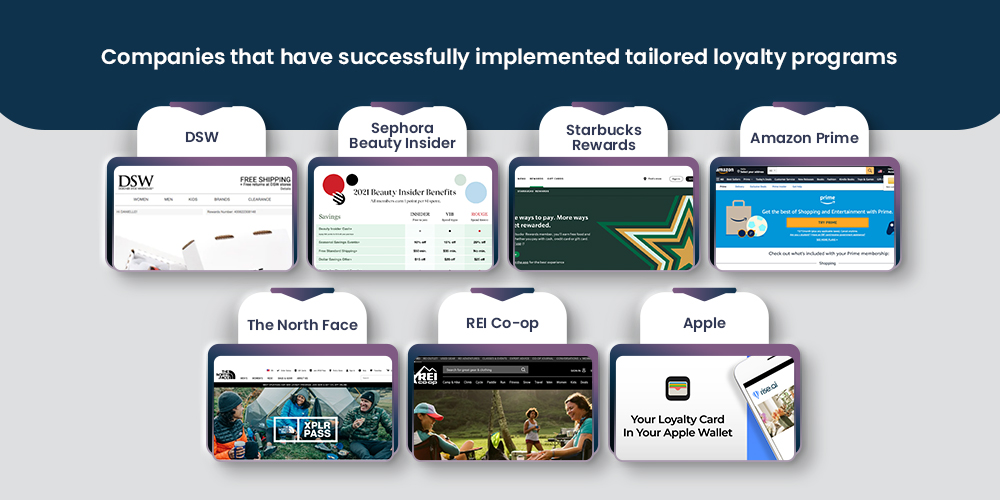
I. DSW
DSW’s VIP loyalty program provides members free shipping, early access to sales, and bonus point opportunities. The program uses personalized promotions and rewards to encourage engagement and repeat purchases.
II. Sephora Beauty Insider
Sephora’s program provides members with exclusive promotions, early product access, and personalized recommendations based on their purchase history. The program also includes a tiered system that rewards customers with increasingly valuable perks as they spend more.
III. Starbucks Rewards
Starbucks Rewards provides members with free drinks, food, and other perks based on their purchase history. The program also includes personalized recommendations and promotions based on customer preferences and behaviour.
IV. Amazon Prime
Amazon Prime provides members with free shipping, exclusive discounts, and access to various streaming services. The program encourages engagement and repeat purchases which have helped improve customer retention and loyalty.
V. The North Face
The North Face’s VI Peak Rewards program provides members early access to sales, free shipping, and personalized recommendations based on their purchase history. The program also includes a tiered system that rewards customers with increasingly valuable perks as they spend more.
VI. REI Co-op
REI Co-op’s loyalty program provides members exclusive discounts, early access to sales, and personalized recommendations based on their preferences and behaviour. This has helped improve customer experience and loyalty and drive repeat purchases and customer retention.
VII. Apple
Apple’s loyalty program, Apple Card, provides members with cashback rewards on their purchases and exclusive access to products and promotions. The program also includes personalized recommendations based on customer preferences and behaviour.
Signing Off
A personalized customer experience is essential for building long-term customer loyalty. By tailoring customer loyalty programs to customer preferences and behavior, businesses can improve the customer experience and foster deeper connections with them.
Tailored loyalty programs can benefit businesses, including increased customer retention, repeat purchases, and revenue. The loyalty programs vary, but they all aim to give customers personalized rewards and benefits to encourage engagement and loyalty.
Therefore, consider implementing a tailored loyalty program to improve customer experience and loyalty. By defining the objectives and goals of the program, customizing rewards and benefits, and communicating effectively with customers, businesses can launch successful loyalty programs that provide value to both the business and the customer.
Thank you for taking the time to read our blog. We appreciate it. Let us know what you think about loyalty programs and their impact on your business.
About The Author
I love navigating the world of SaaS with finesse. As an SEO enthusiast and seasoned Copy Writer, I'm here to transform tech-speak into compelling narratives that resonate with online merchants. With a penchant for alliteration and a touch of humor, I bring a unique flair to SaaS content.
Related Posts
10 Game-Changing Mobile App Marketing Strategies For Growth and Customer Retention
Launching a mobile app might feel like the hard part…
How to Grow Sales After Mobile App Launch: Proven Strategies for Long-Term Success
Mobile App growth goes beyond the initial launch. It’s about…
Why a Mobile App is Essential for Your Shopify Store’s Future Growth
By 2024, mobile commerce is set to hit a staggering…
